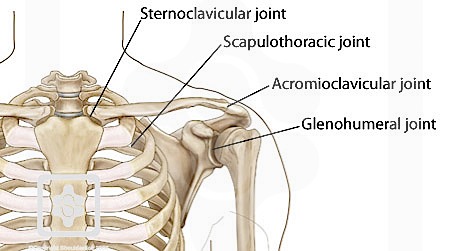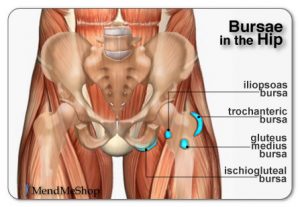Some important joints to know are the:
Glenohumeral Joint – joins the Scapula and the humerus
Acromioclavicular Joint – Joint the Acromion and the Clavicle
Sternoclavicular Joint – Joins the Clavicle and the Sternum
Scapulothoracic Joint – The Scapula glides across the Thorax
There are numerous types of joints though. These include the:
Fibrous, Cartilaginous and Synovial joints.
The ones surrounded with synovial fluid, that go pop when the fluid gets displaced are called (surprise) Synovial joints.
There are 6 types of Synovial Joints:
Condyloid, Hinge, Pivot, Saddle, Ball & Socket and Gliding joints. I remember them with the acronym
CH(i)PS B(a)G
Suture, Syndesmosis, Gomphosis
(There are a lot of S's there, so sorry, but I can't think of a brilliant memory hook for the other joint types.)
There are 2 types of cartilaginous joints:
Symphysis-the fixed or nearly fixed union of bones, as that of the two halves of the lower jaw or of the pubic bones.
Synchondrosis-a type of cartilaginous joint in which the cartilage is usually converted into bone before adult life. The connecting medium is hyaline cartilage.
So yes, if you haven' figured it out, cartilage or cartilaginous joints are made up of different types of cartilage as well.
I get ahead of myself though, as we have not discussed what cartilage actually is?
Cartilage is- Connective tissue which allows tissue to bear mechanical stress. It is more widespread in the infant skeleton, being replaced by bone during growth.
There are three types of cartilage.
- Hyline cartilage-The most abundant type, found as supportive tissues in the nose, ears, trachea, larynx, and smaller respiratory tubes.
- Elastic cartilage- It has the firmness and resiliency of hyaline cartilage as well as flexibility and elasticity. It is found in jointless organs that frequently encounter bending or folding. In the adult human, elastic cartilage is found in the pinna of the ear, the external auditory canal and Eustachian tubes as well as the epiglottis and cuneiform cartilage of the larynx.
- Fibrocartilage- is the tough, very strong tissue found predominantly in the intervertebral disks and at the insertions of ligaments and tendons.
That stuff was a bonus; I love studying this stuff! I mean, isn't it cool to be able to say as you stroke the ears "Does this feel nice to your Hyline and Elastic cartilage?" Or maybe you don't like big fancy words like I do. . .Words are very important though, especially words for the body, as they help us know ourselves. And as a wise man once said:
So here are some terms that help you know your body.
Fossa= Large shallow depression in a bone. (There is also a cute mammal called a fossa FYI.)
 Tuberosity= Large, often rounded, rough projections or grooves.
Tuberosity= Large, often rounded, rough projections or grooves.
Spinous process is a bony projection off the posterior (back) of each vertebra.
Fossa= Large shallow depression in a bone. (There is also a cute mammal called a fossa FYI.)
 Tuberosity= Large, often rounded, rough projections or grooves.
Tuberosity= Large, often rounded, rough projections or grooves.Spinous process is a bony projection off the posterior (back) of each vertebra.
Bursae=fluid filled sacs that serve as a cushion between tendon and bones.
Bursitis= Inflammation of the fluid filled sacs that serve as a cushion between tendon and bones.
("Itis" is always in reference to inflammation, but there is another term for inflammation: monoarticur
Bursitis= Inflammation of the fluid filled sacs that serve as a cushion between tendon and bones.
("Itis" is always in reference to inflammation, but there is another term for inflammation: monoarticur
The opposite is polyarticular, which means noninflammatory.)
These sacs, like our tendons and ligaments are very important, especially around the joints. The Bursae are often neglected as root causes for radiating pain I have read. The 2 most common hip injuries are iliopsoas tendinitis and iliopsoas bursitis. Iliopsoas injuries are poorly recognized as a cause of hip and groin pain. It is located in the groin and higher, but it can be a cause of low back pain, because of how it effects the muscles on the other side of the body.
The largest muscle in the body, called the gluteus maximus muscle as well as most of the hamstrings are antagonists (fight against) to the iliopsoas. When one is tight, the other is consequently strained. . . and that strain effects the entire back as it pulls it down! No amount of work on those strained legs will help your back pain without first dealing with the iliopsoas, or "psoas" for short.
"Iliopsoas Syndrome" refers to a stretched, torn or completely ruptured iliopsoas muscle or tendon, which is frequently experienced along with or causes iliopsoas bursitis. In the case of the latter, the damaged tendon rubs on the bursa sac, causing it to become inflamed. Massage, chiropractic, acupuncture, ice, exercises and physical therapy are good natural helps for Iliopsoas Bursitis, or bursitis of all sorts! Although sometimes more aggressive techniques like therapeutic ultrasound, electrical stimulation, aspiration or surgery are needed. More on this here, and here.
So this was just one example of how the knowledge of antagonist muscles are a key to learning how the body works, and compensates for pain due to just one tight muscle.
In the next post I will deal with not just the typical origin, insertion and action of muscles, but antagonist muscles to them as well.



No comments:
Post a Comment